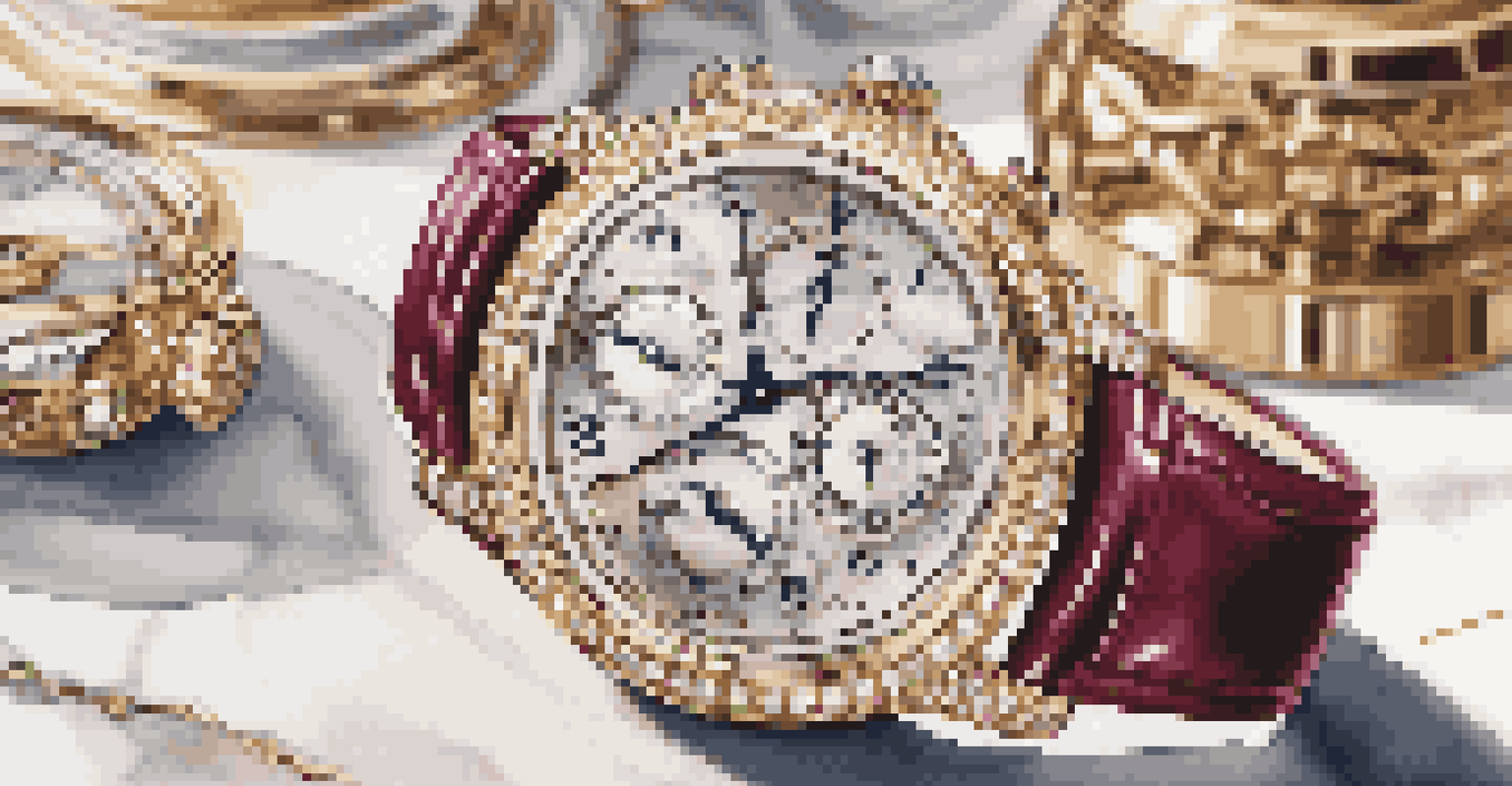Investment Opportunities in Global Luxury Goods Market

Understanding the Global Luxury Goods Market Landscape
The global luxury goods market has seen remarkable growth over the past decade, driven by a surge in affluent consumers and changing spending habits. As of 2023, the market is valued at hundreds of billions of dollars, with projections indicating continued growth. This sector encompasses a wide range of products, from high-end fashion and jewelry to luxury automobiles and premium cosmetics.
Luxury is the balance of design, in the sense of beauty and highest quality.
Emerging markets, particularly in Asia-Pacific, are becoming key players, as rising disposable incomes and a burgeoning middle class are fueling demand for luxury items. China, for instance, has become the largest luxury market globally, contributing significantly to the industry's expansion. Understanding these dynamics is crucial for investors looking to capitalize on this lucrative market.
Moreover, the luxury goods market is evolving with trends such as sustainability and digitalization. Brands are increasingly focusing on eco-friendly practices and engaging consumers through online platforms, presenting new investment avenues. By staying informed about these trends, investors can better position themselves to take advantage of growth opportunities.
Key Drivers of Growth in the Luxury Goods Sector
Several factors are driving the growth of the luxury goods market. One significant driver is the increase in disposable income among consumers, particularly in emerging economies. As more individuals attain wealth, their purchasing power expands, leading to greater spending on luxury goods and experiences.

Another important factor is the rise of e-commerce, which has transformed the way consumers shop for luxury items. With more brands establishing online platforms, customers can easily access a wide range of products, enhancing convenience and boosting sales. This shift has also allowed luxury brands to reach a global audience, opening new markets for investment.
Luxury Market Growth Drivers
Key factors such as rising disposable incomes and the influence of e-commerce are propelling the growth of the luxury goods market globally.
Additionally, the growing influence of social media cannot be overlooked. Platforms like Instagram and TikTok have become key marketing tools for luxury brands, allowing them to engage with consumers and promote their products effectively. This digital presence not only attracts new customers but also fosters brand loyalty, further solidifying the market's growth.
Emerging Trends in Luxury Consumer Behavior
Consumer behavior in the luxury market is continually evolving, with new trends emerging that investors should pay attention to. One notable trend is the shift towards experiential luxury, where consumers prioritize experiences over material goods. This shift has given rise to investments in luxury travel, fine dining, and exclusive events, providing exciting opportunities for savvy investors.
Sustainability is no longer about doing less harm. It's about doing more good.
Additionally, younger generations, particularly Millennials and Gen Z, are becoming significant players in the luxury market. These consumers are more inclined to support brands that align with their values, such as sustainability and social responsibility. As a result, luxury brands are adapting their strategies to resonate with this demographic, creating new avenues for investment in ethical luxury products.
Moreover, personalization and customization are becoming increasingly important for luxury consumers. Brands that offer tailored experiences, whether through bespoke products or personalized shopping services, are gaining traction. Investors can look for opportunities in companies that prioritize customer experience and innovation.
The Role of Technology in Luxury Goods Investment
Technology plays a pivotal role in shaping the luxury goods market, influencing both production and consumer engagement. The rise of artificial intelligence and data analytics is enabling brands to understand consumer preferences better and tailor their offerings accordingly. This technological advancement presents investment opportunities in companies that leverage these tools for enhanced customer experiences.
Moreover, the integration of augmented reality (AR) and virtual reality (VR) in shopping experiences is revolutionizing how consumers interact with luxury brands. For instance, virtual try-ons for fashion items and immersive brand experiences are gaining popularity, attracting tech-savvy consumers. Investors should consider companies that are at the forefront of these innovations.
Sustainability Shapes Investments
The increasing demand for sustainable and ethically sourced luxury products is creating unique investment opportunities in the market.
Furthermore, blockchain technology is increasingly being adopted for authentication and traceability in the luxury market. As counterfeiting remains a significant concern, brands that utilize blockchain to ensure product authenticity are becoming more appealing to consumers. Investing in technology-driven solutions can lead to substantial returns in this evolving market.
Sustainability: A Growing Focus in Luxury Investments
Sustainability has become a central theme in the luxury goods market, with consumers demanding more environmentally friendly and ethically sourced products. Luxury brands are responding by adopting sustainable practices, from sourcing materials responsibly to reducing their carbon footprint. This shift presents a unique investment opportunity for those looking to support eco-conscious companies.
Moreover, sustainability is not just a trend; it's becoming a core value for many luxury brands. Companies that prioritize sustainable practices often see enhanced brand loyalty and consumer trust, which can translate into increased sales and revenue. Investors can capitalize on this growing focus by identifying brands that are committed to sustainability.
Additionally, the rise of second-hand luxury goods is a testament to changing consumer attitudes toward sustainability. Platforms for reselling luxury items are gaining popularity, allowing consumers to buy and sell pre-owned products. This trend creates investment opportunities in businesses that facilitate the circular economy within the luxury sector.
Navigating Risks in Luxury Goods Investments
While the luxury goods market offers enticing investment opportunities, it is not without its risks. Economic fluctuations can significantly impact consumer spending on luxury items, making it essential for investors to stay informed about global economic conditions. A downturn could lead to decreased demand, affecting sales and profitability for luxury brands.
Another risk involves brand reputation, which is crucial in the luxury market. Any negative publicity or misalignment with consumer values can lead to a decline in brand loyalty. Investors should conduct thorough research on a brand's history and reputation before committing to investments, ensuring they align with consumer expectations.
Technology Transforms Luxury Shopping
Innovations like AI, AR, and blockchain are revolutionizing consumer engagement and product authenticity in the luxury goods sector.
Additionally, the luxury market is highly competitive, with numerous brands vying for consumer attention. New entrants and shifting consumer preferences can disrupt established players, affecting market dynamics. Investors must remain agile and adaptable, continuously monitoring market trends and consumer behavior to make informed decisions.
Conclusion: Seizing Opportunities in the Luxury Market
In conclusion, the global luxury goods market presents a wealth of investment opportunities for those willing to navigate its complexities. By understanding the market landscape, key growth drivers, and emerging consumer trends, investors can position themselves to capitalize on this thriving sector. With technology and sustainability at the forefront, the luxury market is evolving, offering innovative avenues for investment.
Moreover, as the market continues to grow, staying informed about risks and challenges is crucial. By conducting thorough research and maintaining an adaptive strategy, investors can mitigate potential pitfalls while reaping the rewards of this lucrative market. The key is to remain engaged and responsive to the ever-changing landscape of luxury consumer behavior.

Ultimately, the luxury goods market is more than just a trend; it's a reflection of evolving consumer values and desires. By aligning investments with these changes, investors can not only achieve financial success but also contribute to a more sustainable and ethical luxury industry.